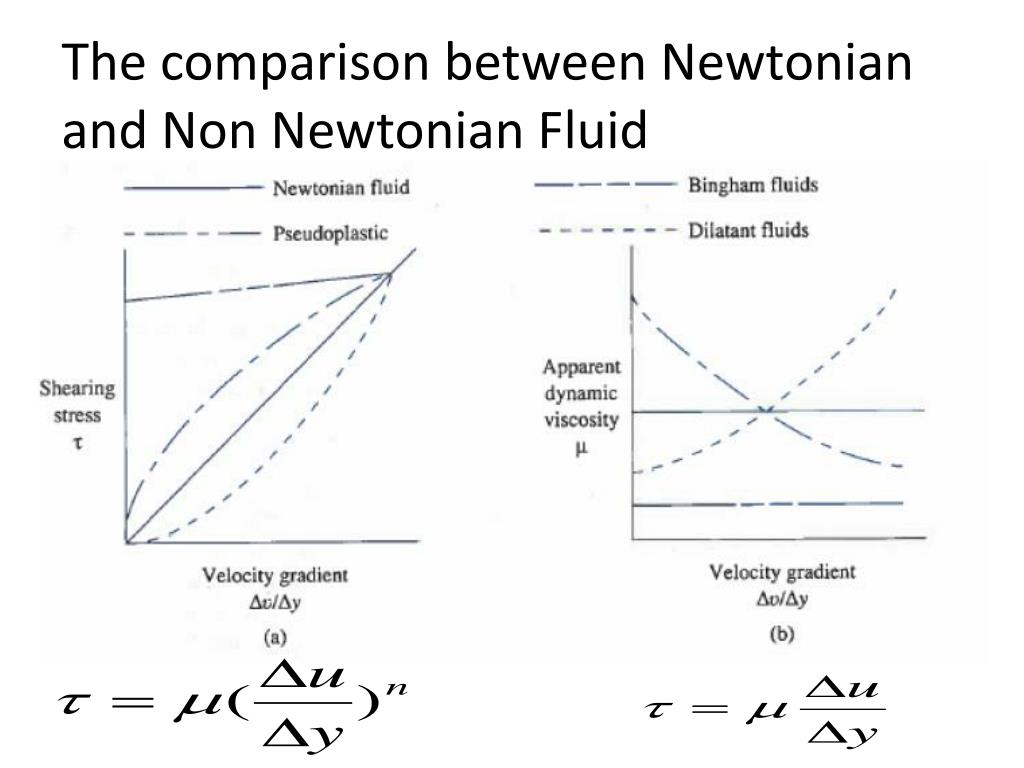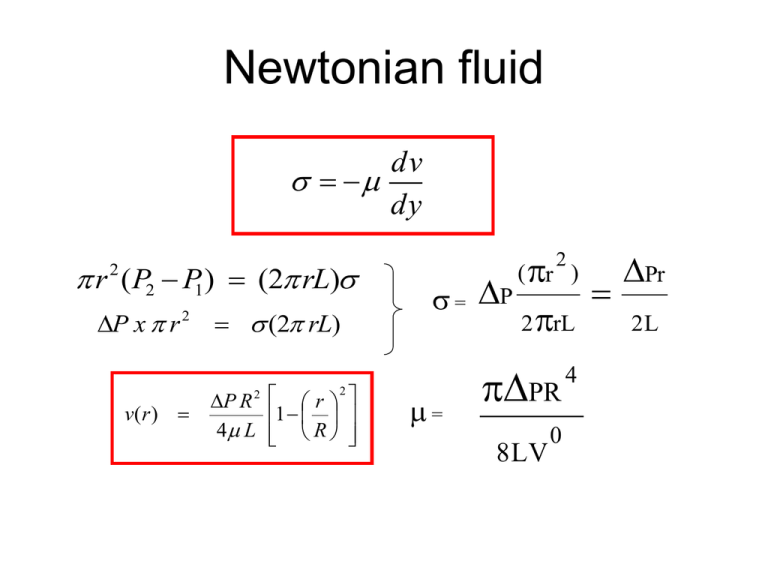
How to Measure Viscosity Food Science Toolbox
A subfield of physics known as fluid dynamics studies how fluids behave in various situations. The contrast between Newtonian and non-Newtonian fluids is an intriguing element of fluid dynamics. In many practical applications, it is essential to comprehend their contrasts. Think of ketchup as an example to help you understand the idea.

Non Newtonian Fluids slide share
A Newtonian fluid is a fluid in which the viscous stresses arising from its flow are at every point linearly correlated to the local strain rate — the rate of change of its deformation over time. [1] [2] [3] [4] Stresses are proportional to the rate of change of the fluid's velocity vector .

PPT Devices to measure Pressure PowerPoint Presentation ID6623701
Fluids can be categorised based on how they behave when a force is applied, and fluids can be considered as Newtonian or non-Newtonian. Fluids such as water,.

Newtonian and NonNewtonian Fluids The Importance in Processing
Non-Newtonian fluids. Many people have heard of Sir Isaac Newton. He is famous for developing many scientific theories in mathematics and physics. Newton described how 'normal' liquids or fluids behave, and he observed that they have a constant viscosity (flow). This means that their flow behaviour or viscosity only changes with changes in.

PPT Fluid Mechanics LAB MeasuringViscosity & Specific gravity
What Are Newtonian and Non-Newtonian Fluids? Written by Sara Peters May 15, 2023 Understanding fluid properties that are either Newtonian or Non-newtonian impacts the sizing and selection of pump equipment.

PPT Modelling the Flow of nonNewtonian Fluids in Porous Media
Non-Newtonian fluids need to be measured under varying stress or shear rate to yield shear stress versus shear rate data to obtain the real behavior of the system. Non-Newtonian fluid viscosities must be compared at equivalent shear rates to be meaningful. The glass capillary tube is a common technique used in lubrication to measure viscosity.

NonNewtonian Fluids FluidFlow
(PDF) Written by Anup Kumar Dey in Process Have you ever wondered why some substances flow smoothly, while others seem to behave in unpredictable ways? The answer lies in the fascinating world of fluid dynamics, where two distinct categories of fluids emerge: Newtonian and Non-Newtonian fluids.

NonNewtonian Fluids
The main difference between Newtonian and non-Newtonian fluids is that Newtonian fluids are fluids that obey Newton's laws of constant viscosity, whereas Non-Newtonian fluids are fluids that do not have constant viscosity. Fluid is a liquid, gas, or other material that continually deforms under an applied shear stress or external force.

ABOUT THE BLOGGER Thongchai Thailand
A Newtonian Fluid is one where there is a linear relationship between stress and strain-rate: the ratio of stress to strain-rate is the viscosity of the fluid. A Hookean solid is one where there is a linear relationship between stress and strain: the ratio of stress to strain is the modulus of the solid.

Difference Between Newtonian and Non Newtonian Fluids Compare the
Newtonian & Non-Newtonian Fluids and Viscosity. With Newtonian fluids, viscosity does not depend on the shear rate. If pumped oil has a 300-cSt viscosity, for example, it stays so at 3,600 rpm or 1,800 rpm. The shear rate changes, but the viscosity is still 300 cSt. However for some fluids (non-Newtonian), viscosity does change—either up or.

Difference Between Newtonian and Non Newtonian Fluids Compare the
Newtonian vs Non-Newtonian Fluids. It is important to note that not all fluids are Newtonian. Some fluids exhibit properties known as non-Newtonian behavior. Unlike Newtonian fluids, which maintain a constant viscosity regardless of shear rate, force, or time, non-Newtonian fluids exhibit variable viscosity dependent on these factors.

newtonian and non newtonian behaviour of fluids
A key difference between Newtonian and Non-Newtonian fluids is their reaction to the forces they experience during processing. WHAT IS VISCOSITY? Viscosity is a measure of a fluid's resistance to flow. In a processing system, some fluids' viscosity changes when they come in contact with, for example, a rotating impeller inside a pump.

Newtonian and Non Newtonian Fluids LancetinHeath
A non-Newtonian fluid is a fluid that does not follow Newton's law of viscosity, that is, it has variable viscosity dependent on stress. In particular, the viscosity of non-Newtonian fluids can change when subjected to force. Ketchup, for example, becomes runnier when shaken and is thus a non-Newtonian fluid.

NonNewtonian Fluids, part 2 Lecture 1.6 Chemical Engineering Fluid
Fluids of which the viscosity, or internal friction, must be taken into account are called viscous fluids and are further distinguished as Newtonian fluids if the viscosity is constant for different rates of shear and does not change with time.

Newtonian and NonNewtonian Fluids Newton's Law of Viscosity
Newtonian fluids are named after Sir Issac Newton (1642 - 1726) who described the flow behavior of fluids with a simple linear relation between shear stress [mPa] and shear rate [1/s]. This relationship is now known as Newton's Law of Viscosity, where the proportionality constant η is the viscosity [ mPa-s] of the fluid:

Typical rheogram of Newtonian and nonNewtonian fluids Download
Newtonian vs. non-newtonian fluids definition. Newtonian fluid is defined as a fluid that obeys the viscosity law as propounded by Sir Isaac Newton (popularly referred to as "Newton's law of viscosity"). The fluids' viscosity remains unchanged irrespective of pressure or force.